Dude! Take Your Turn!
A Gaming Life
Review – Shipwrights of the North Sea – Redux
What do you do if you love ships but you’re afraid of being out on the water so you can’t actually go sailing?
Especially if you’re a Viking?
You get a job building them instead of sailing them!
That’s the premise of Shipwrights of the North Sea – Redux (ok, maybe without the “I’m afraid to be out on the water” part; I might have extrapolated too much there).

Shipwrights of the North Sea – Redux (from now on, just assume I’m talking about the the new Redux version and not the original that has a really bad reputation, ok?) was designed by Shem Phillips way back in 2014, but the new updated (and supposedly much better) version came out in 2024.
It has art from Mihajlo Dimitrievski and was published by Garphill Games and Renegade Game Studios.
It’s a card-drafting, simultaneous action game that plays in an hour or so once players know what they are doing, which makes it a perfect lunchtime game, or “filler” game at the beginning or end of a game night, especially if you have 5 players.
We all know about 5 players, right?

But you can with Shipwrights!
Does it play well, though?
Let’s take a look.
The card-drafting mechanism in this game works pretty well.
The game goes over 5 rounds and each player will end up drafting 6 cards in a round.
Unlike 7 Wonders and other drafting games, though, you won’t be playing these cards right away.
You will instead have them in your hand for the frantic simultaneous action phase!
Ok, it’s not that frantic.
But it is simultaneous!
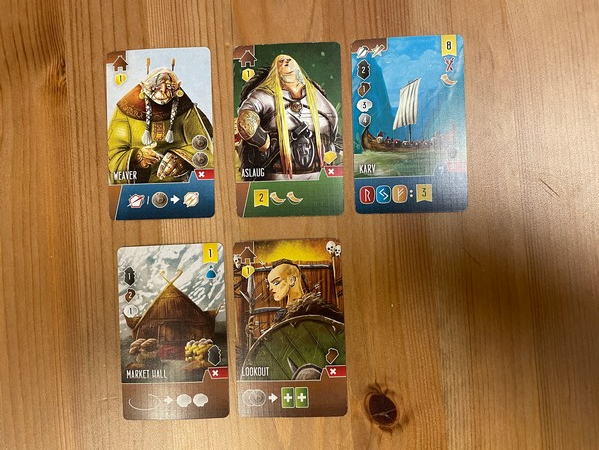
The cards you may get in your hand range from craftspeople whose skills you need to build the ships (which you can also get) to townsfolks and buildings.
Maybe you’ll get some buildings that will give you a space to play a worker?
Or a townsfolk or jarl that you can pay a gold to place under one of your already-constructed buildings?
That way you will always have their ability (or just getting endgame points for the jarls).
You can always discard cards for the resources they will give you (above the red “X” on the right side). This can get you silver, stone, wood, wool, a worker, a card, or even gold if you discard a jarl.
The decisions as far as which cards you want to keep and build or use, and which ones you want to discard for their resources to help you build other cards, really remind me of one of the best parts of It’s a Wonderful World (which also has the simultaneous action phase, now that I think about it).
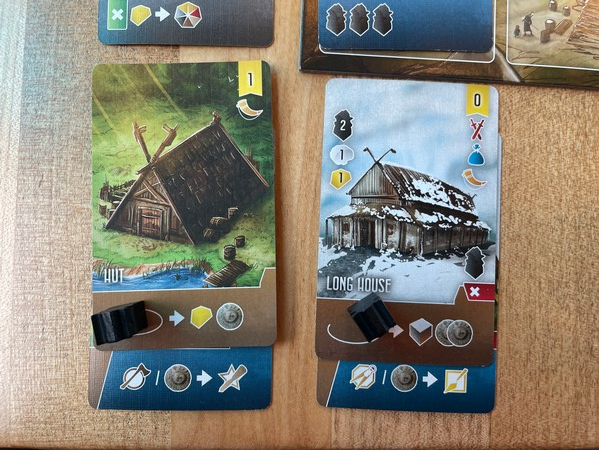
Each player will start with three workers and will gain a worker as income every round, so you are looking for places to use them that will help you in your shipbuilding conglomerate.
You always start with a Hut and there are also two worker spaces on your player board as well.

But some things will make you spend workers to build them, like many ships (are they sailors going off to sea?) or even buildings such as the Longhouse above (I’m not sure what that represents).
Thus, you will be spending workers and trying to get them back, and you have to watch how many workers you are spending because you also need them for the resource-gathering spaces.
It’s sometimes a Catch-22!
Of course, the name of the game is “Shipwrights,” so one of your options is constructing ships.
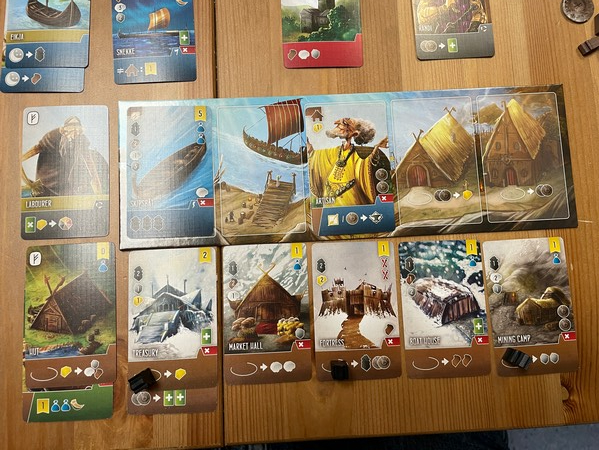
When you have your hand of cards, you can always place a ship on your player board so that it’s under construction.
Each ship requires one or more types of skilled craftspeople to make it, you know, not sink when it goes out on the water.
Another great mechanic in this game is the ability to play your craftspeople (and townsfolk as well) in one of two ways.
Craftspeople can take up a spot on your player board, like the picture above.
If you use that skill to build a ship, the craftsperson gets discarded.
However, you can also pay a gold to place them under one of your constructed buildings.

This allows that skill to be used as often as you need it.
For the townsfolk, placing the person under a building lets you do that action whenever you place a worker on the building they’re attached to.
So if the person allows you to spend a gold to gain six silver, then when you do the action of the building you can also do that!
These mechanics are really interesting and I enjoy them a lot.
Like most Garphill games, there is a bunch of iconography (though I don’t think anything can match some of the South Tigris games), so a player aid would have been nice to get it all sorted out.
Hmmm…somebody should write about that.
That being said, the iconography in this game isn’t too bad and it’s all very intuitive.
There aren’t too many icons that make you scratch your head in wonder.

Once you’ve completed a ship, it goes out above your board and goes sailing!
Some ships will give you income in between rounds, some will give you an instant effect, and some will give you endgame points (in addition to the points in the top right corner of the card that all ships have).
Also in the top right are the symbols which are a major part of this game (though after three games, I haven’t figured out how to make them actually score for me): the three tracks you’re moving along.
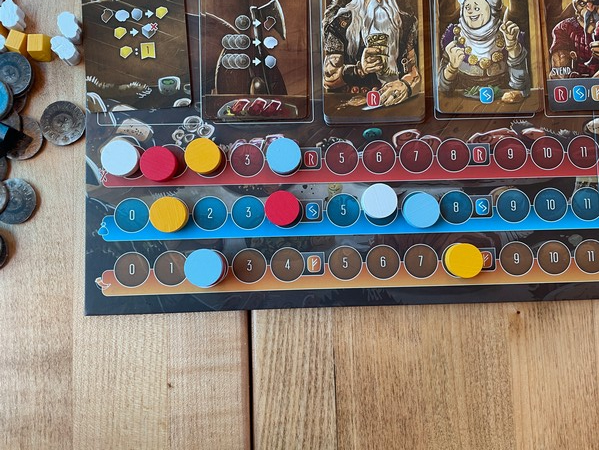
Whenever you build a ship, and many buildings, you will move your marker along the indicated tracks based on the symbols.
This is really the only player interaction in the game, the desire to be ahead of everybody else on these tracks.
(Some would say the drafting is interactive, but are you going to waste one of your six cards on taking something you can’t use just because somebody else might want it? Probably not).
When you reach 4, 8 and 12 on each track, you qualify for a bonus.
The military track (red) gives you raid cards.
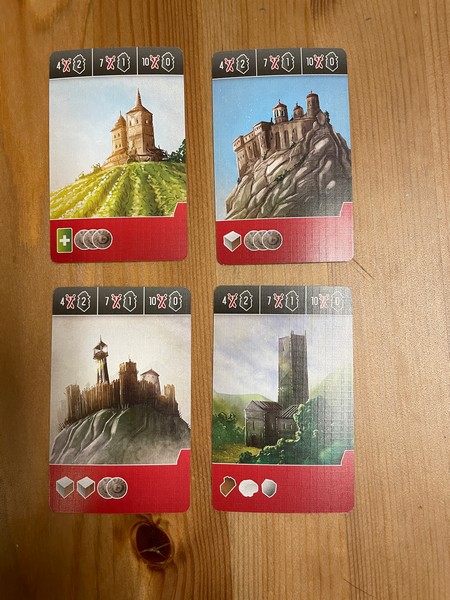
These raid cards give you another action you can do during your action round, if you want to spend the workers (or get high enough up on the track that it doesn’t cost workers).
Essentially, it’s a poor village that you just keep tormenting in order to get resources.
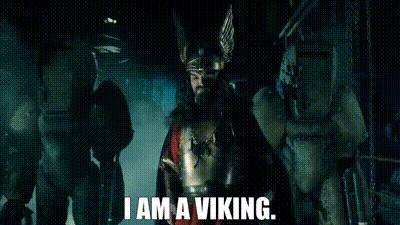
Yes, yes you are.
Hitting the milestones on the blue track gives you trade cards.

At the end of each round, you will gain income based on your ships and trade cards (your starting ship already gives you a worker).
These trade cards have to be placed under an already-constructed ship (so you already have one) and will give you additional resources.
Or you can just spend them immediately for their top immediate bonus (which you have to do if you don’t have any empty completed ships).
Hitting the milestones on the bottom track lets you upgrade one of your starting cards, either your hut, your Labourer (I love how the game uses the “correct” spelling of Labourer!), or your starting ship.
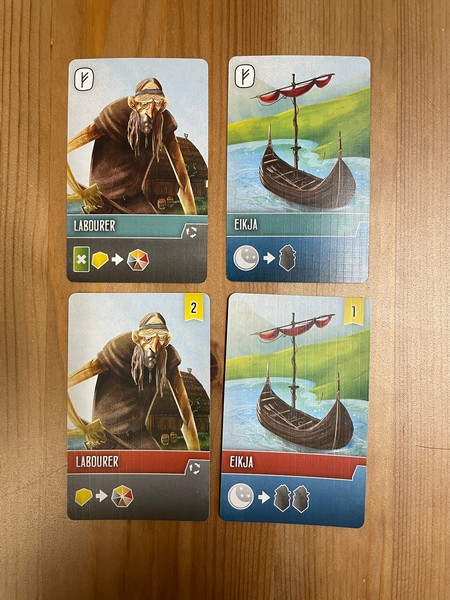
These will make them worth points but also upgrade their abilities, like your ship giving you two workers at income instead of just one.
Is it worth it to try to evenly go up all of the tracks?
Not if you want to get endgame points for your track movement.
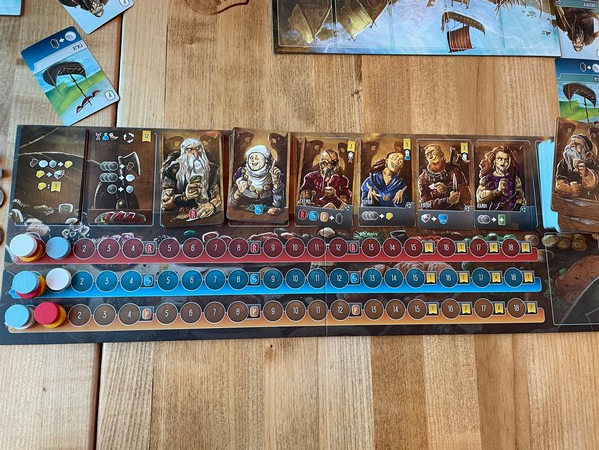
See the right side of the board?
You have to hit level 15 to even get one point.
I suppose you could if you really hammered it with jarls (who give you track movement when you place them under buildings) along with the right combination of buildings and ships.
More plays of the game may illustrate how to do this better, but for now we don’t even worry about it.
I do like the rewards at certain levels for each one, though.
It’s nice to get more options and gives you a reason to concentrate on the tracks a little bit.
As always, there is a tradeoff, especially with the buildings.
Some of the better buildings will give you less (or maybe even no) track movement. However, buildings like the Longhouse give you no points but three track movements.
The ships, on the other hand, get you better stuff all around but cost more resources and require more skills to build.
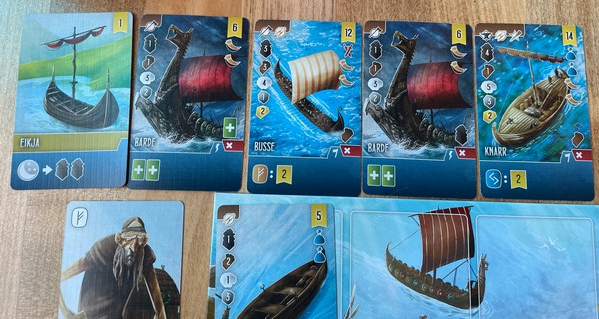
The ships that give you more points and also endgame points also give you a lot of track movement.
But you’re not going to build them quickly or cheaply!
Building ships is yet a different balancing act.
Is it better to build a bunch of cheaper ships?
Or go for the high point, high reward, really fracking expensive ones?
The last thing to say about the tracks is that, at the end of each round, whoever is ahead on a track gets that track’s Hero.
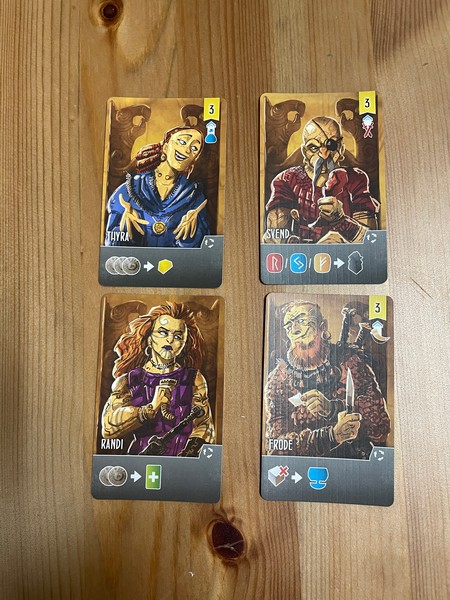
The heroes give different abilities.
If you’re ahead on the military track, then you will get Svend, who will give you a worker in the next round every time you hit a track milestone.
The best one, though, is Frode (for being ahead on the bottom track). With him, you can spend one less basic resource to build a ship.
That can come in handy!
If you don’t qualify for any heroes, then you get Randi. She just lets you spend two silver to draw a card, which isn’t bad if you have a big silver engine going on.
After the 5 rounds are completed, if you qualified for one of the main heroes, then you’ll get 3 points at the end of the game.
All of this is lather, rinse, repeat, for the five rounds before you total up all of your points from the buildings, ships, tracks (ha!), and other point sources.
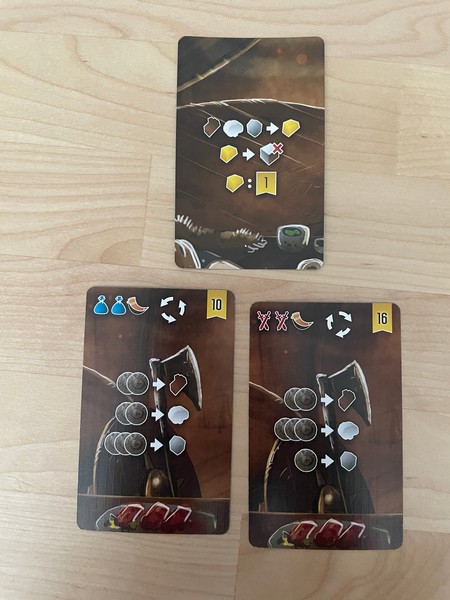
I do like how each round has the value of each basic resource change, as well as telling you which direction you are delivering your cards for the draft.
(The other symbols are only used in solo or 2-player games).
The top card is actually the back of all the round cards, telling you trades you can always make (one of each basic resource for a gold, a gold can be any basic resource for building things, etc).
There is a bit of strategy (or tactics, I guess) if you have a lot of money left over in a round, that you may want to buy up some of the cheap stuff (stone in the above example) before the next round hits and it costs 3 silver instead.
Little things like that I really enjoy.
I also like how quickly the game plays, but that leads to one strike against it (and really, all games like this though some are worse than others).
The simultaneous actions are great! It makes the round go by very fast, though you are often waiting for the person who has an intricate plan, exchanging resources for other resources, placing their many workers in their many building slots to get more resources, finally figuring out that they have enough for that really expensive ship…
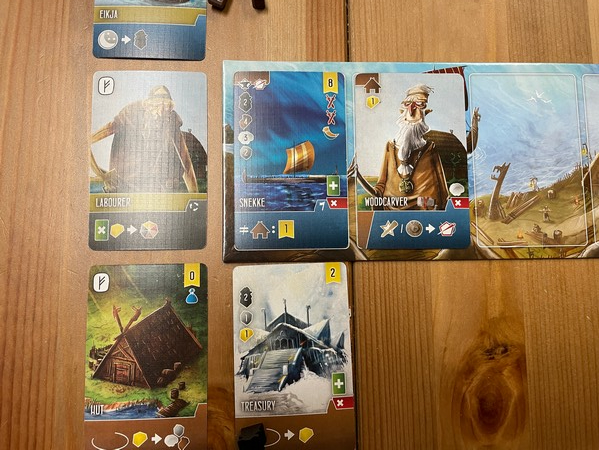
but then “oh crap! I don’t have the craftsperson for it!”
Can they reverse everything they did and try a new path? Maybe that ship they discarded for a stone earlier would actually be a better one to build?
That can be difficult.
Or maybe you just made a mistake? You actually should have paid 4 stone for that ship and you only paid 3 because you thought you had one stone in the pile of resources that you put back into the supply.
In a game where nobody is watching anybody else do their stuff, it is very easy to accidentally cheat.
You’re not intending to, but you missed something and nobody else caught it because they were doing their own thing.
This really doesn’t happen in 7 Wonders because everything’s pretty simple.
In a game like this, though? Sure, this isn’t a heavy game by any means, but there are a lot of interactions going on as you discard cards, play cards, pay for cards, etc.
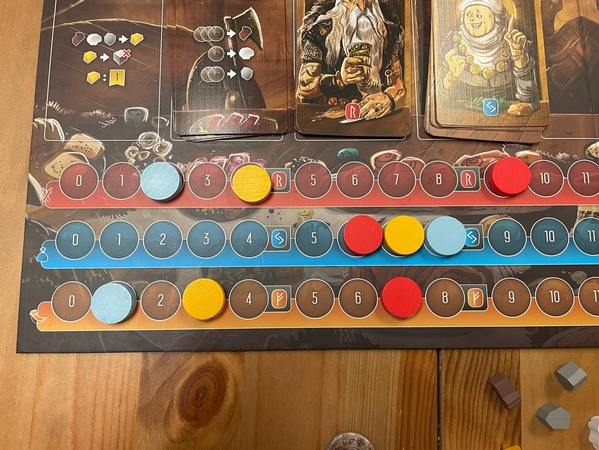
Another small knock is that while I love that it plays up to 5 players, it can start to drag with more players, even with the simultaneous actions.
That’s mainly because the more players you have, the more chances there are that one or more of the players will be doing a huge, intricate turn that requires a lot of time and calculation.
The final mild thing I have to say, and this definitely depends on your preference, is that this is almost the definition of multiplayer solitaire.
Other than the draft (and again, I can’t imagine hate-drafting in this game unless that card also benefits you in some way, and how much are you paying attention to what the other players are doing anyway?), there is no interaction in this game at all.
The racing on the track for heroes, ok. Maybe a little. But again, you have your own goals and what tracks you move on will also be based on what cards you are able to get.
Which brings out the randomness that any card game is going to have.
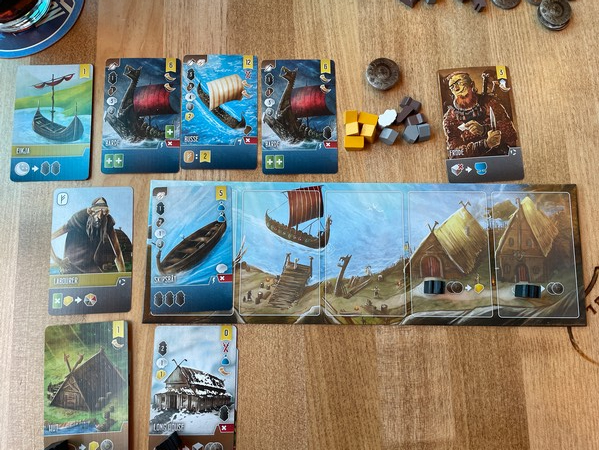
There could be rounds where, even with all of the cards that come out (depending on player count, of course, as the more players, the more cards will be available), you never see the skill that you need for the ship you want to build.
Yes, your Labourer lets you spend a gold and discard a card (or just spend a gold if you’ve upgraded him) to take the place of any skill you need and don’t have, so it’s like dice mitigation.
But it’s still annoying sometimes.
This will involve some tactical rearranging of goals, and it’s certainly fine.
I don’t mind that kind of thing, personally.
But keep that in mind if you are not a fan of randomness.
I enjoyed Shipwrights of the North Sea, and will willingly play it at any time.
It fits our lunches at work great (we only have 3 players at work, which helps). It fits that roughly an hour time frame if you’ve finished your long game a bit too early.
The artwork is amazing to look at (unless you’ve tired of The Mico’s artwork, which I know some people have, but I certainly haven’t).
Will it ever be in my top echelon of games?
No. It doesn’t give me that “wow” factor that so many other of these games do.
It’s a respectable game, and apparently much better than the original.
Give this one a “solid” rating.
Now get me off this pier because I’m getting seasick.
This review was written after 3 plays
Pingback: New to Me – March 2024 – Dude! Take Your Turn!